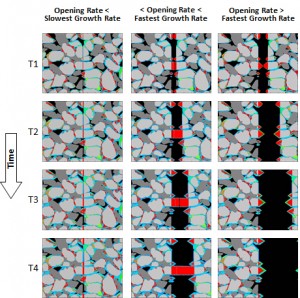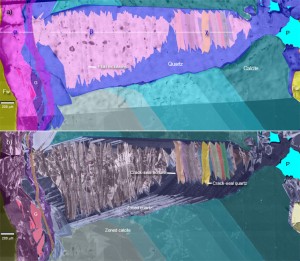Background and Links

Fracture cement model. Lander & Laubach 2015
A challenge for geoscientists is to understand fractures in the deep subsurface. Fluid flow in fractured rock is increasingly important in recovering water and hydrocarbon supplies and geothermal energy, in predicting flow of pollutants underground, in engineering structures, and in understanding large-scale crustal behavior. Natural fractures, a major unknown in unconventional oil and gas reservoirs, can interact with engineered hydraulic fractures in surprising ways. Yet learning about fractures is not easy. Fractures are exceedingly hard to sample in meaningful ways, and models to date have been hard to test, partly because fractures formed by different processes can look alike—if analysts don’t know what to look for.
Structural Diagenesis
Meeting the challenge of accurate fracture characterization and prediction has been the mission of the Structural Diagenesis Initiative. And breakthroughs have come from looking at the old problem of fractures in new ways. Since the first scientific notice of fractures in the 1800’s, the starting point for understanding fractures has been mechanics—a reasonable perspective given everyday experience. Rigorous application of fracture mechanics continues to yield insights.
But for fractures in the deep subsurface, mechanics, no matter how complete, is inadequate. In the presence of reactive fluids like hot water, ubiquitous in the subsurface, chemical reactions are essential. Sedimentary petrologists study chemical reactions that convert sediment to rock—diagenesis—but typically neglect fractures.

Scanning-electron-microscope images of structural diagenetic textures within fractures. The linear feature in the center is a cement deposit called a bridge formed during fracture opening. Such bridges, discovered in SDI research, allow researchers to measure key aspects of fractures, such as opening rate, that were previously inaccessible. Results can test predictive models and improve subsurface fracture diagnostics (Laubach et al., 2010).
Focusing on the geochemical reactions in fractures and surrounding rocks was a breakthrough that led to new, more effective and accurate ways of predicting and characterizing fractures—an approach called structural diagenesis[i]—a new research and training paradigm in sedimentary geochemistry and structural geology, and a new discipline.
Structural diagenesis is the study of the relationships between deformation or deformational structures and chemical changes to sediments. In high-temperature deformation research, the alliance of structural geology and petrology is essential. But no such alliance supports research and student training on the increasingly important structural and diagenetic phenomena in lower-temperature environments in sedimentary basins.
Such an alliance—structural diagenesis—can help unlock knowledge about the low-temperature realm of sedimentary basins that is of great intrinsic and practical interest.
Background Literature
- Insights into rates of fracture growth and sealing from a model for quartz cementation in fractured sandstones. Lander R.H., and Laubach, S.E., 2015, Geological Society of America Bulletin, v. 127, no. 3-4, p. 516-538. doi: 10.1130/B31092.1 (published online October 2014) | view at publisher
- Structural diagenesis. Laubach, S.E, P. Eichhubl, C. Hilgers, R.H. Lander, 2010, Journal of Structural Geology, v. 32, no. 12, p.1866-1872. doi:10.1016/j.jsg.2010.10.001. | view at publisher
- SDI Publications page
- Notable papers
Connecting SDI science with Society | An overview of SDI science and goals written for the general public was recently published in Scientia. | For PodCast | For the web version | For a printable version | For twitter | For Facebook
Project Faculty and Research Staff
A list of senior scientists associated with the initiative can be found on the project research collaborators page.
The following brief profiles outline research interests of some of the participants.
| Stephen E. Laubach | Structural geology/structural diagenesis | BEG |
| Jon E. Olson | Geomechanics/petroleum engineering | PGE |
| Randall Marrett | Structural geology/nonlinear dynamics | DGS |
| Rich Schultz | Geomechanics | PGE |
| Chris Landry | Flow modeling; imaging | PGE |
| Peter Eichhubl | Geomechanics/geochemistry | BEG |
| Julia F. W. Gale | Structural geology/shale | BEG |
| Andras Fall | Fluid inclusions/geochemistry/experimental diagenesis | BEG |
| Esti Ukar | Structural geology/petrology/carbonates | BEG |
| Sara Elliott | Microstructural imaging | BEG |
| Maša Prodanović | Flow modeling/petroleum engineering | PGE |
| Sergey Fomel | Geophysics | BEG/DGS |
| Rob Lander | Diagenetic modeling/structural diagenesis | BEG/Geocosm |
| Linda Bonnell | Diagenesis/basin modeling | BEG/Geocosm |
For more information, contact Steve Laubach, Jon Olson, Rich Schultz, Randy Marrett, or Peter Eichhubl.
Software and Methods | List of papers organized by topic
Links to Related Sites
Fracture Research & Application Consortium
Geocosm: Advanced diagenesis research
Geological Society of America Structural Diagenesis Award
Structural Diagenesis Award on Facebook
AAPG Petroleum Structure & Geomechanics Division
Research Gate SDI project
[i] Laubach, S.E, P. Eichhubl, C. Hilgers, R.H. Lander, 2010, Structural diagenesis. Journal of Structural Geology, v. 32, no. 12, p. 1866-1872. doi:10.1016/j.jsg.2010.10.001 | view


